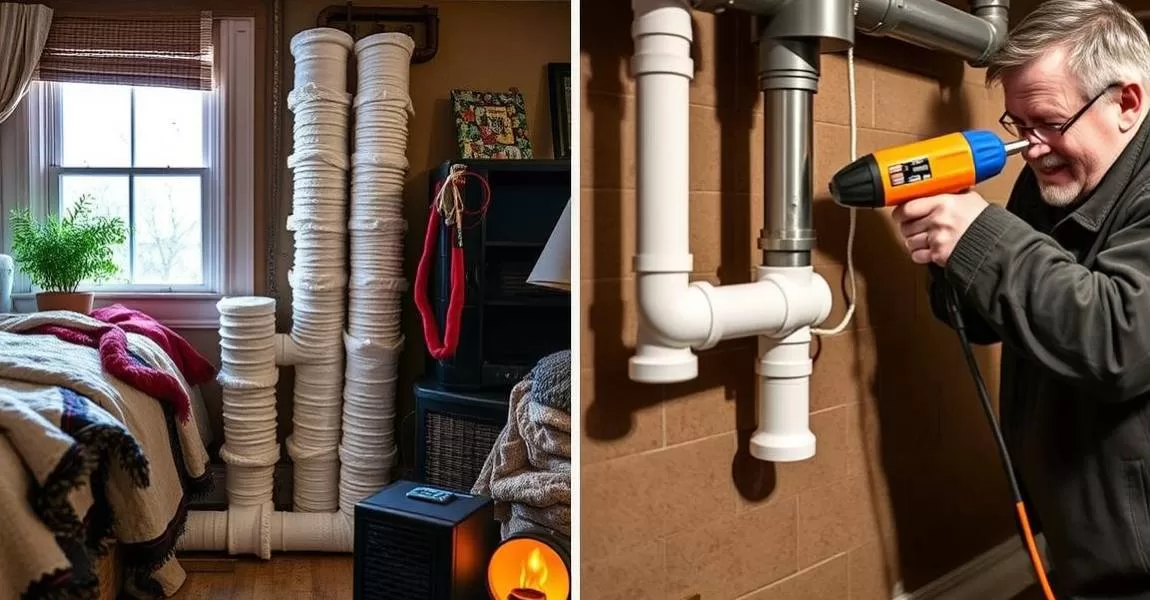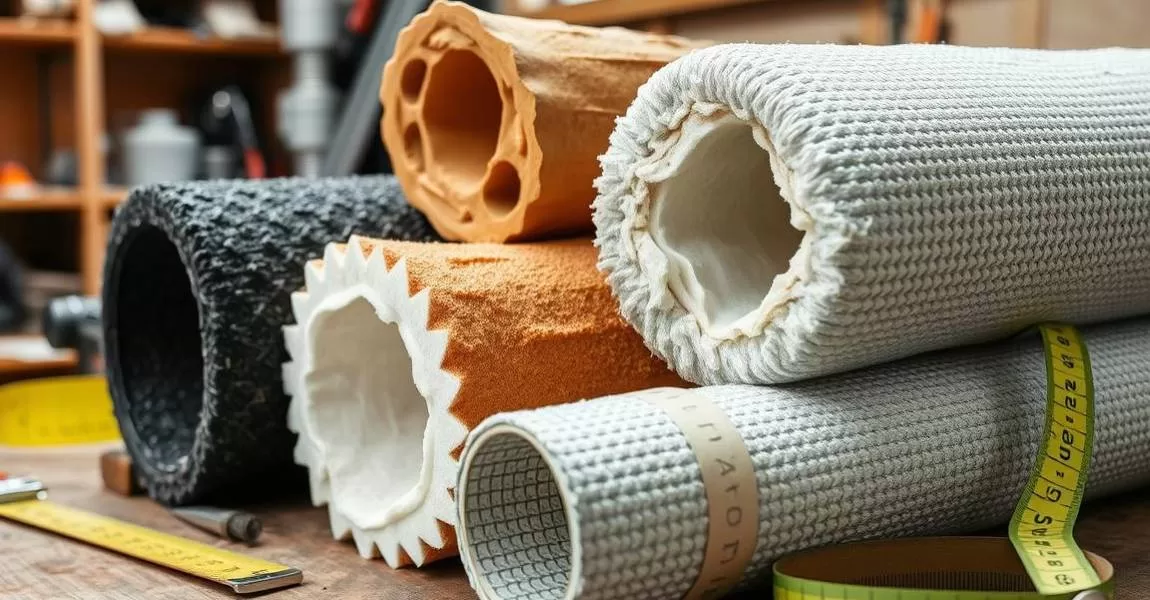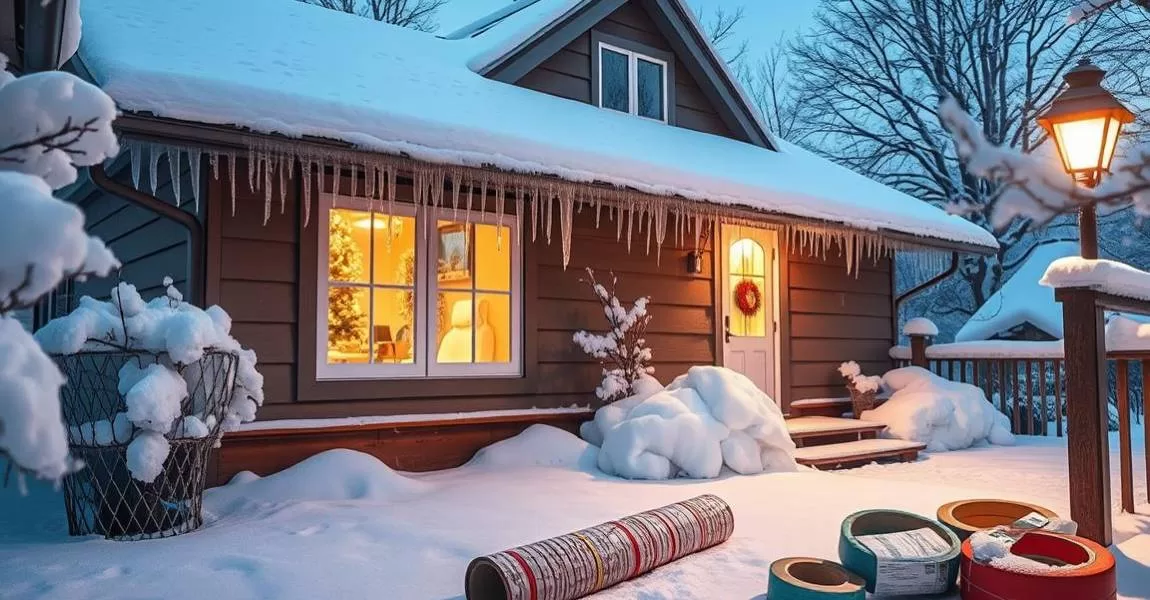Did you know a burst pipe can cost up to $5,000 in water damage? Frozen pipes are a common problem in winter. They can lead to expensive repairs and a lot of stress. It’s important to take steps to prevent and fix freezing pipes to protect your home.
This guide will teach you all about keeping your pipes safe during winter. You’ll learn about the risks and how to solve them. You’ll get practical tips to avoid pipe disasters. For expert help, call JD’s Plumbing, Heating and Air Conditioning at 720 735 9170.

Key Takeaways – Freezing Pipes
- Frozen pipes can cause extensive water damage and costly repairs.
- Preventing and repairing frozen pipes is critical in winter.
- Simple winter plumbing tips can protect your home.
- Professional services like JD’s Plumbing offer expert solutions.
- Acting early can save you from major plumbing emergencies.
Table of Contents-Freezing Pipes
Understanding the Risks of Freezing Pipes
Winter weather can damage your home, mainly through freezing pipes. Knowing the risks helps you protect your property and avoid expensive fixes.
Why Pipes Freeze
Pipes freeze when it gets colder than 32°F. Water inside expands, which can cause cracks or bursts. This is more likely in uninsulated or exposed pipes. Poor heating or ventilation makes areas more vulnerable.
Common Problem Areas in Your Home
Some parts of your home are more likely to have frozen pipes. These include:
- Basements and crawl spaces
- Attics and garages
- Outdoor spigots and hose bibs
These areas often lack insulation or heating. This makes them hotspots for winter plumbing problems.
The Cost of Frozen Pipe Damage
Frozen pipe damage can be very costly. Burst pipes can flood your home, causing structural damage and mold. This can cost thousands of dollars to fix. Preventive steps now can save you money later.
Early Warning Signs of Freezing Pipes
Spotting early signs of freezing pipes can save you from expensive repairs and water damage. Knowing what to look for is key in preventing frozen pipes. Here are the most common indicators that your pipes may be at risk:
- Reduced water flow: If your faucets are trickling instead of flowing, it could mean ice is blocking the pipes.
- Unusual noises: Gurgling or banging sounds from your pipes often signal trapped air caused by freezing.
- Frost buildup: Visible frost or ice on exposed pipes is a clear warning sign.
- No water: If no water comes out of your faucets, the pipes may already be frozen.
- Condensation: Moisture on pipes in cold areas can indicate freezing conditions.
“Early detection is your best defense against frozen pipes. Acting quickly can prevent bursts and save your home from extensive damage.”
Water control for frozen pipes involves shutting off the main water supply to prevent flooding and opening faucets to relieve pressure. Proper insulation and maintaining a steady indoor temperature can help avoid freezing in the first place.
If you notice any of these signs, it’s important to act fast. Learning how to thaw frozen pipes safely can prevent further issues. For expert advice and assistance, call JD’s Plumbing 720-735-9170 . Their team specializes in detection, prevention, and repair, ensuring your home stays protected all winter long.
Essential Steps for Preventing and Repairing Frozen Pipes
Preventing frozen pipes can save you a lot of trouble and money. Knowing what to do right away and in the long run is key. Here’s how to keep your home safe during winter.
Immediate Prevention Techniques
When it gets cold, act fast to stop pipes from freezing. Open cabinet doors to let warm air reach the pipes. Let faucets drip a bit to reduce pressure.
Seal any cracks or gaps in walls or foundations. This keeps cold air out.
Long-term Prevention Strategies
Invest in insulation for your pipes to keep them safe. Wrap exposed pipes in attics, basements, and crawl spaces. Think about installing heat tape for extra protection.
Check your home for weak spots and fix them before winter starts.
Emergency Response Methods
If you think a pipe is frozen, act quickly. Turn off the main water supply to stop it from bursting. Use a hairdryer or heating pad to thaw it slowly.
Avoid using open flames, as they can damage the pipe. For tough problems, call JD’s Plumbing, Heating and Air Conditioning at 720 735 9170 for help.
By following these steps, you can lower the chance of frozen pipes. This way, your home will stay warm and safe all winter.
Professional Pipe Insulation Techniques
Keeping your home safe from freezing temperatures is key. Professionals use advanced methods to protect your pipes. This prevents costly repairs and keeps your pipes working well.

- Foam Pipe Sleeves: Easy to install and highly effective for indoor pipes.
- Fiberglass Wrapping: Ideal for outdoor pipes, providing excellent thermal resistance.
- Heat Tape: A reliable solution for pipes in extremely cold areas.
Insulation helps reduce heat loss and keeps water flowing. It’s a smart investment that saves you from expensive repairs. Hiring a pro ensures your pipes are well-insulated, giving you peace of mind.
“Insulating your pipes is not just a preventive measure—it’s a smart way to protect your home and wallet.”
Think about getting a licensed plumber to check your home. They can suggest the best insulation for your property.
Emergency Steps When You Discover Frozen Pipes
Discovering frozen pipes can be stressful. But, acting quickly and safely can prevent costly damage. Knowing the right steps is key in such emergencies. Here’s what you need to do to address the issue effectively.
Locating the Frozen Section
Start by finding where the pipe is frozen. Look at areas that get cold, like basements, attics, or exterior walls. If water isn’t flowing from a faucet, the blockage is likely nearby. Use your hands to feel for unusually cold spots on the pipe.
Safe Thawing Methods
Once you’ve found the frozen section, start thawing it carefully. Use a hairdryer, heating pad, or warm towels to gently warm the pipe. Always start from the faucet end and work your way toward the blockage. Avoid using open flames or high-heat devices, as they can damage the pipe or cause a fire.
What Not to Do
In your urgency, avoid common mistakes that can worsen the situation. Never use a blowtorch or propane heater, as they pose serious safety risks. Don’t leave the pipe unattended while thawing, and avoid excessive force to open faucets. If you’re unsure or the situation escalates, contact emergency plumbing services immediately.
- Keep faucets slightly open to relieve pressure as the pipe thaws.
- Insulate exposed pipes to prevent future freezing.
- For urgent assistance, call JD’s Plumbing, Heating and Air Conditioning at 720 735 9170.
Taking these steps can help you manage frozen pipes effectively. For complex issues or persistent problems, professional help ensures your home stays safe and functional.
Winter Home Maintenance Checklist for Pipe Protection
Getting your home ready for winter is key to avoid expensive fixes from frozen pipes. A good winter home maintenance plan keeps your plumbing working well, even when it’s cold. First, check your home for drafts and seal any gaps around windows, doors, and foundations. This is a vital part of keeping your home warm.

- Insulate exposed pipes in unheated spots like basements, attics, and garages.
- Keep your thermostat at a steady temperature, even when you’re not home.
- Disconnect and drain outdoor hoses, and turn off exterior water valves.
- Open cabinet doors under sinks to let warm air reach the pipes.
- Think about using pipe sleeves or heat tape for extra protection.
Check your home’s insulation often and upgrade if needed. Good home winterization not only keeps your pipes safe but also saves energy. By following this checklist, you can protect your home from winter’s cold and enjoy peace of mind all season.
Advanced Leak Detection and Prevention Methods
Keeping your home safe from plumbing problems is more than just basic upkeep. Modern tech and smart home tools can spot leaks early and stop expensive pipe fixes. These methods save money and give you peace of mind, even in bad weather.
Modern Detection Technologies
Today’s leak detection systems use high-tech sensors to watch your plumbing live. They can find tiny leaks before they turn into big problems. For instance, sound sensors catch the sound of water leaking, and moisture sensors warn of leaks in hidden spots. Using these tools can greatly lower the chance of water damage.
Smart Home Solutions
Smart home gadgets take leak detection further. Systems like LeakSmart and Flo by Moen link to your phone, sending alerts if a leak is found. Some let you turn off your water from afar, stopping more damage. These are great for people who travel a lot or want to check their plumbing from anywhere.
- Real-time alerts for immediate action
- Remote water shutoff capabilities
- Integration with other smart home devices
Adding these advanced methods to your home keeps you ahead of plumbing troubles. It avoids the stress of sudden pipe repairs. Early detection and prevention are essential for a safe and efficient plumbing system.
When to Call a Professional Plumber
Dealing with frozen pipes can be stressful. Sometimes, DIY methods aren’t enough. Knowing when to call a professional can save you time, money, and prevent damage. Emergency plumbing services are key when you need help right away.
Emergency Situations
Certain situations need a professional plumber’s help. Here are signs you should call for assistance:
- Burst pipes causing significant water leakage
- No water flow despite attempts to thaw the pipes
- Visible cracks or damage to the plumbing system
- Unusual noises like banging or gurgling in the pipes
Service Options Available
Professional plumbers like JD’s Plumbing, Heating and Air Conditioning offer many services. They can help with frozen pipe repair and other emergencies. Their team provides:
- Quick response to emergency calls
- Expert assessment of the plumbing system
- Safe and effective thawing techniques
- Long-term solutions to prevent future freezing
If you’re facing a plumbing emergency, don’t hesitate. Contact JD’s Plumbing at 720 735 9170 for reliable and efficient service.
Cost Considerations for Pipe Protection and Repair
Keeping your home safe from winter plumbing problems needs both initial and ongoing spending. Knowing the costs helps you plan better and avoid surprises. Fixing frozen pipes can cost between $200 and $1,000 or more. This depends on how bad the damage is and where the pipes are.
Acting early with insulation and regular checks can save you money later. Here’s a look at what you might spend:
- Pipe Insulation: $1-$2 per foot for materials, plus labor if you get a pro.
- Heating Cables: $50-$100 each, great for spots like basements and crawl spaces.
- Emergency Repairs: Costs can jump up fast, if water damage happens.
Going for prevention cuts down on the need for costly repairs. Regular checks and updates can make your plumbing last longer. This keeps you worry-free during the cold months.
Thinking ahead and saving for seasonal upkeep can ease financial worries. Remember, preventing problems is cheaper than fixing them after they happen.
Seasonal Maintenance Tips for Year-Round Protection
Keeping your plumbing system safe all year is key. A seasonal maintenance plan helps avoid expensive fixes and keeps your pipes in great shape. Here are important steps for fall, winter, and spring.
Fall Preparation Steps
Fall is the best time to get your home ready for cold weather. Start by disconnecting and draining outdoor hoses to stop them from freezing. Check your pipes for cracks or leaks and seal any gaps in walls or foundations.
Think about getting professional home winterization services for a detailed check Contact JD’s Plumbing 720-735-9170.
Winter Monitoring Protocols
In winter, watch your plumbing closely to prevent frozen pipes. Keep indoor temperatures above 55°F, even when you’re away. Open cabinet doors to let warm air reach your pipes.
If you see water flow decrease, act fast to thaw the pipe safely.
Spring Assessment Guide
When it gets warmer, check your plumbing for winter damage. Look for leaks, cracks, or wear. Clean your gutters and downspouts to ensure water flows right.
Get a professional to inspect your system to fix any problems early.
By following these seasonal tips, you can protect your home and avoid plumbing emergencies. Being proactive keeps your system working well all year.
Conclusion: Protecting Your Home from Frozen Pipe Disasters
Keeping your home safe from frozen pipes is key during the cold months. Knowing the risks and acting early can save you from big problems. Simple steps like insulating pipes and sealing gaps can help a lot.
If you find frozen pipes, act fast and safely. Don’t use open flames to thaw them. For bigger issues, call a pro like JD’s Plumbing, Heating and Air Conditioning. They’re ready to help at 720 735 9170.
Make these tips part of your winter routine. It’s not just about saving money; it’s about feeling safe at home. Let JD’s Plumbing keep your home cozy all year.
FAQ’s Freezing Pipes
What are the early warning signs of freezing pipes?
Early signs of freezing pipes include reduced water flow and unusual noises. You might also see frost on exposed pipes. It’s vital to act fast to avoid serious damage.
How can I prevent my pipes from freezing in the first place?
To prevent pipes from freezing, insulate exposed pipes and seal drafts. Keep indoor temperatures steady. Use heat tape or cable too. Regular checks on your plumbing system can also help.
What should I do if I discover frozen pipes in my home?
First, find the frozen section of pipes. Then, use a space heater, hair dryer, or other gentle heat to thaw them. Don’t use open flames or too much heat, as it can harm the pipes. If you can’t thaw them, call a plumber.
How can professional pipe insulation techniques help prevent frozen pipes?
Professional insulation techniques use special materials and correct installation. They keep pipe temperatures steady, lowering the chance of freezing and bursting.
When should I call a professional plumber to deal with frozen pipes?
Call a plumber for emergencies like burst pipes or if you can’t thaw them safely. Plumbers have the skills and tools to fix frozen pipes quickly, reducing damage to your home.
How can I protect my home’s plumbing system year-round?
Protect your plumbing system all year by insulating pipes in fall and watching for freezing signs in winter. Inspect the system in spring. Being proactive keeps your pipes safe from the elements.





